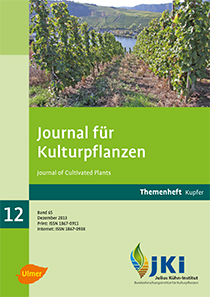Effects of copper contamination in viti culture on earthworm cenosis – results of field surveys
DOI:
https://doi.org/10.5073/JfK.2013.12.01Keywords:
Viniculture, soil contamination, total copper load, effects on earthwormsAbstract
On the basis of a survey that had been initiated in 2009 to assess the copper content in the upper 20 cm soil layer in the main wine culturing regions of Germany upon which already has been reported (Riepert et al., 2010, and Strumpf et al., 2011 and 2012a), a comprehensive sampling project was designed to assess the effects on earthworms on population level. It was decided to perform a pre-survey with 8 wine growing farms were selected for a field survey of effects on earthworm populations on cultured sites of organic farming. The design of the survey included besides load aspects also aspects of bio-availability by including a broad range of soil specific parameters. Sampling periods were chosen according to the activity periods of earthworms relevant for our climate zone and resulted in a sampling schedule comprising 4 farms in autumn 2010 and 4 in spring 2011. At each farm typically 3 sites, one under cultivation, one at best without any cultivation (control) and one that had been cultivated in the past but without cultivation in the last 10 years, with copper loads similar to that on the site under cultivation at present (reference). In each treatment group 4 × 0.25 m2 soil samples, regularly distributed over the trial site, earthworms were extracted by means of hand sorting and formalin extraction according to DIN ISO 11266-1.
The evaluation of the extraction indicated that total abundance was a rather insensitive parameter at low and medium copper loads and comparisons of means didn’t result in significant differences of abundance between control and testing site due to the high variation between replicates. Comparing abundance attributed to ecological life forms or species diversity revealed effects instead. In the majority of the assessed sites an evaluated on the level of ecological life forms was sufficient to detect effects. Diversity indices (Shannon-Wiener) that have been calculated for the different types of field sites included in the survey are consistent with these observations. At both extraction periods, in autumn 2010 and spring 2011, a negative correlation was found between the total copper content in soil and the diversity index determined. Summarizing the effects on abundance by taking into account statistical aspects, significant differences in the abundance of earthworms found on testing and reference fields on one hand and control sites on the other hand were observed at Cu-concentrations > 100 mg Cu/kg soil dry mass and most frequently with endogeic species. This result is supported by results of a discriminant analysis on the main factors of variance, revealing that copper is only playing a major role in the variance of abundance for endogeic worms. For the other life forms factors like site specific soil characteristics or nutrient supply seem to play a more important role.
By analysing the internal copper contents in worms that had been transferred from the field site into the laboratory, first information was gained on the uptake behaviour. According to these data the height of uptake depends on the copper concentration in soil but without indicating any bioaccumulation. The intensity of uptake seems to be different for the three life forms, with highest accumulation at anecic worms followed by epigeic worms. The different accumulation observed for the life forms in addition differed between the two extraction periods indicating a much better correlation of soil and body burdens in data gained with the autumn extraction in 2010.
A definitive analysis of the effects of copper load in quality vine growing regions of Germany on site specific earthworm communities cannot be given before the results of the ongoing projects are presented. Interpreting the data available, clear evidence is given for effects on population level at a concentration level of 100 mg Cu/kg (DW) soil. It will be up to a benefit-risk analysis, what consequences have to be drawn with respect to sustainable wine culturing.
Downloads
Published
Issue
Section
License
The content of the journal is licensed under the Creative Commons Attribution 4.0 License. Any user is free to share and adapt (remix, transform, build upon) the content as long as the original publication is attributed (authors, title, year, journal, issue, pages).
The copyright of the published work remains with the authors. The authors grant the Journal of Cultivated Plants, the Julius Kühn-Institut and the OpenAgrar repository the non-exclusive right to distribute and exploit the work.







